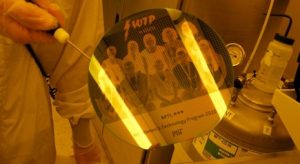Regional network efficiencies
The efficacy of the comprehensive and ambitious plan that is proposed here can be enhanced considerably by exploiting substantial regional network efficiencies that are available. We see ample experience in our university community of multi-disciplinary, multi-institution research programs that span the entire country. This approach–one that pools capabilities and expertise from those best qualified, regardless of geography– has proven to be highly effective. The core of a scaled microelectronics research plan should, likewise, have a nationwide dimension.
Nevertheless, accomplishing the goals articulated in this white paper will involve the engagement of institutions (colleges, universities, community colleges, high school and middle schools, community centers such as science museums) that have not traditionally been part of the U.S. microelectronics enterprise. Further, smaller educational institutions with distinguished educational or research programs that are limited in scope and size could enlarge their involvement under the proposed initiative. Widely expanding the number of players, scaling up their activities, and engaging a highly diverse population of students is singularly essential to accomplishing the workforce education goals of this plan. It is in this quest that regional network effects can be helpful.
 We envision a loose confederation of institutions that coordinate research, education, outreach, and internship activities at a regional scale. The notion of “region” will necessarily differ around the country. To the first order, we think of this as empowering access to substantial resources within a two-to three-hour car drive. This makes possible the regular use of facilities, routine participation in established programs, and the construction of day-long and multi-day programs that cater to a large geographically dispersed community.
We envision a loose confederation of institutions that coordinate research, education, outreach, and internship activities at a regional scale. The notion of “region” will necessarily differ around the country. To the first order, we think of this as empowering access to substantial resources within a two-to three-hour car drive. This makes possible the regular use of facilities, routine participation in established programs, and the construction of day-long and multi-day programs that cater to a large geographically dispersed community.
Programs should be created to facilitate access to technical expertise and shared experimental and design facilities if regional institutions are to support existing and new research and educational programs. Joint research projects that engage neighboring institutions previously sitting on the sidelines should be created. Funding for visiting appointments, internships, and summer research experiences will greatly assist this mission.
Widely expanding the number of players, scaling up their activities, and engaging a highly diverse population of students is singularly essential to accomplishing the workforce education goals of this plan.
Educational facilities, content and know-how also can be effectively pooled at a regional scale through a mixed in-person/online approach, as we have come to appreciate over the last year. Similarly, outreach and industrial internship programs can be coordinated and expanded on a regional scale. Startup support and technology transition efforts also benefit from regional proximity by cataloging regional resources and coordinating access protocols.
Across all these dimensions, regional-level meetings, conferences, informal get-togethers, career fairs, startup exchanges, educational competitions, and other networking events can contribute greatly to the whole.